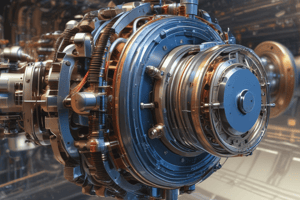Podcast
Questions and Answers
What is the definition of mass?
What is the definition of mass?
- The amount of space occupied by an object
- The force of gravity acting on an object
- The velocity of an object
- The amount of matter in an object (correct)
What is the force of gravity described by?
What is the force of gravity described by?
- Fg = m1 + m2
- Fg = m1 - m2
- Fg = Gm1m2 / r^2 (correct)
- Fg = r / m1m2
What type of force is friction?
What type of force is friction?
- A force that opposes motion (correct)
- A pushing force
- A force that aids motion
- An attractive force
What is compression?
What is compression?
What is the characteristic of forces?
What is the characteristic of forces?
What is the result of the sum of forces acting on an object with no acceleration?
What is the result of the sum of forces acting on an object with no acceleration?
What is the nature of the force of gravity?
What is the nature of the force of gravity?
What can be found by summing the potential energy, kinetic energy, and work done by friction?
What can be found by summing the potential energy, kinetic energy, and work done by friction?
What is the unit of measurement used to quantify tension?
What is the unit of measurement used to quantify tension?
According to Newton's First Law of Motion, an object in motion will stay in motion unless acted on by what?
According to Newton's First Law of Motion, an object in motion will stay in motion unless acted on by what?
What is the relationship between acceleration and mass according to Newton's Second Law of Motion?
What is the relationship between acceleration and mass according to Newton's Second Law of Motion?
What is the underlying reason for a greater atmospheric pressure at Earth's surface?
What is the underlying reason for a greater atmospheric pressure at Earth's surface?
What is the result of the attractive force of gravity acting on air molecules?
What is the result of the attractive force of gravity acting on air molecules?
What is the term used to describe the tendency of an object to resist a change in motion?
What is the term used to describe the tendency of an object to resist a change in motion?
What is the relationship between force and acceleration according to Newton's Second Law of Motion?
What is the relationship between force and acceleration according to Newton's Second Law of Motion?
What is an example of Newton's Third Law of Motion?
What is an example of Newton's Third Law of Motion?
Flashcards are hidden until you start studying
Study Notes
Principles of Mechanical Devices
- The ASVAB test section covers mechanical advantage, simple machines, compound machines, structural support, and properties of materials.
Mass
- Mass is the amount of matter in an object, independent of gravity.
- Matter is anything that has mass and takes up space.
Force
- Forces are interactions between two or more objects, possessing magnitude and direction.
- Forces can be thought of as "pushes" or "pulls" (e.g., attraction, repulsion, gravity, electric force).
- When an object experiences no acceleration (constant velocity), the sum of forces acting on it is zero.
Gravity
- Gravity is the force of attraction between two masses.
- Gravity is described by the equation: Fg = G * m1 * m2 / r^2.
- Gravity is only attractive and the reason objects fall towards the ground.
Friction
- Friction is the force opposing an object in motion, always opposite to the direction of motion.
- Friction arises from microscopic interactions between surfaces.
- In a system involving friction, total energy is found by summing potential energy, kinetic energy, and work done by friction.
Compression and Tension
- Compression is a force applied inward, squeezing an object.
- Tension is a force exerted when pulling, typically measured in pounds or Newtons.
Newton's Laws of Motion
First Law
- An object at rest will stay at rest, and an object in motion will stay in motion unless acted on by an outside force.
- This law is also referred to as the law of inertia.
Second Law
- The acceleration of an object is directly proportional to the force exerted, and inversely proportional to its mass.
Third Law
- For every action, there's an equal and opposite reaction.
Fluid Dynamics
- Questions typically relate to air pressure, water pressure, and filling/emptying tanks.
Air Pressure
- Air pressure is the weight of the atmosphere surrounding Earth, caused by the attractive force of gravity.
- Atmospheric pressure is greater at Earth's surface due to increased atmospheric density.
Studying That Suits You
Use AI to generate personalized quizzes and flashcards to suit your learning preferences.




